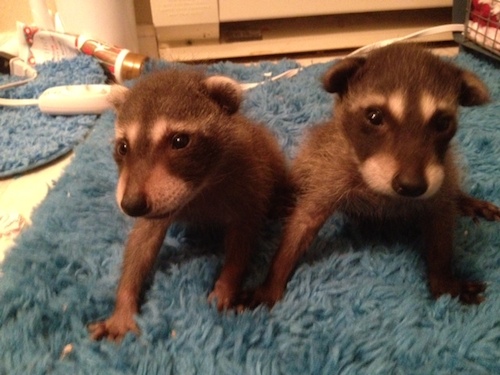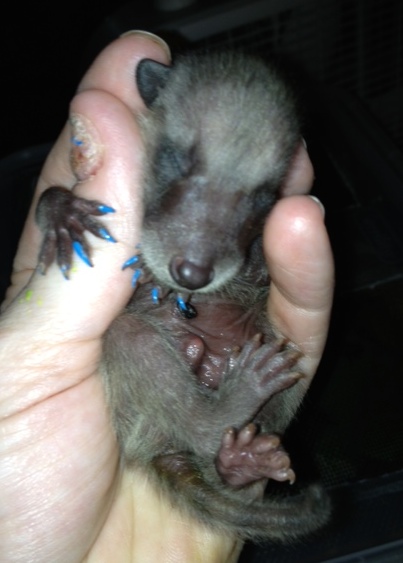Earlier this summer I wrote a blog post asking if my "progress not perfection" mantra was wrong (you can read it here).
A day later, a friend of mine sent me a thread from a vegan forum that bashed the post, with one commenter saying: "I have to disagree about 2% being 'great.' No, it's not. Doesn't really save any animals or improve health."
I wanted to sort of publicly respond and ask other Herbies' thoughts, so I posted on HH's Facebook page:
"Why doesn't it matter that we save one chicken? Does it have to be all the chickens? 20 chickens or none? Science also tells us that a single Big Mac can be the difference between having a heart attack or not... I believe even 1% change matters."
One of the comments I received was from Jules, who wrote: "Saving one chicken matters to that chicken."
I couldn't have agreed more! That was EXACTLY my point. I soon found out that Jules is a wildlife rehab volunteer and asked if she would guest post to discuss her amazing work.
I'll let Jules take it away!

So, as the Happy Herbivore has said about the farm animals, every life saved is worth it!
For me, it is the same with the wild animals I encounter as a volunteer wildlife rehabilitator.
I don't see the (wild, domestic, or farm) animals as percentiles or as numbers, I see each individual animal, with a spirit, a desire (and right) to live, and as a unique and sentient being. It isn't all or nothing; it is one life (saved) at a time. This is our (animal lovers) "revolution," and it isn't glamorous or dramatic; it is often tedious, and it is hard work. As a Vegan, my volunteer work with wildlife is my passion, and is extremely important to me.
Nationwide, many of the licensed wildlife rehabilitators (rehabbers) are volunteers, who "rehab" at home, and receive no salary or compensation. Most who rehab, buy their own supplies (For example, the raccoon kits (babies) are often fed a commercial-grade raccoon milk-replacement formula). Some rehabbers network to start their own wildlife rescue (non-profit, 501c3), so they can save more animals, educate the public on co-existing with wildlife, and educate people about humane solutions to human-wildlife issues. I am lucky to be able to volunteer for the Hope 4 Wildlife Rehabilitation Center (H4WRC)!
Every wild animal has its own history, its own story. Some stories start as heart-breaking, but end happily as the animal is released back to the wild. Although, as a volunteer, I have worked with many species of wild animals, my favorite species is the raccoon!
Depending on the age, a raccoon kit (baby) needs to be fed three to eight times a day, or every 2.5 to 4.5 hours, around the clock. And, because a baby wild raccoon cannot eliminate (pee or poop) on its own, it needs to be stimulated (gently rubbed in the genital and anal areas). It cannot thermoregulate (maintain its own body temperature), it needs to be kept warm. Eventually, it will need to be taught all the skills it needs to survive in the wild; forage for food, climb, seek a den, avoid predators, avoid humans. Although the raccoons are handled a lot when they are young, they "wild up" quickly as they grow. When the raccoon is ready (and old enough), it is released to the wild. Its destiny is to be wild and free.

When a homeowner calls a commercial "wildlife removal" or "nuisance wildlife" service, often a trapper responds, and then kills the "nuisance" wildlife (many of whom are mothers), which leaves orphans. Without us, these babies die. (One exception to trappers is Urban Wildlife Rescue Inc. in Denver, Colorado.)
Humane wildlife removal services use non-violent, sustainable, and compassionate solutions to resolve human-wildlife issues. Using these methods, animals are not killed, and there are no orphans left behind. Mother Nature is much better at raising her babies than we are. If more people would live peacefully with wildlife, there would be less wild orphans.
Much of the work rehabbers (and humane wildlife removal services) do is to educate the public about how to peacefully co-exist with wildlife. "Co-existing with wildlife" means resolving conflicts with wildlife, like raccoons, by not trapping and killing the mother raccoon, which means no orphans. Whenever possible, if babies are found, we try to reunite them with the mother, if there is a chance she is still alive.
We give each individual, sentient, precious being a second chance to live. When they are old enough, they are released to the wild. Home-based rehabbers can help only so many animals, and often local wildlife rehab centers are full (at capacity) early in the year.
They typically stay with the rehabber until they are five to six months old. At that time, they can climb, forage for food, and find shelter on their own; however they tend to stay close together if the litter is released together. Where and how they are released depends on the state where they reside.
The raccoon kits (babies) have painted nails to tell them apart. (The nail polish is non-toxic and Vegan.)
People who work with Rabies Vector Species (RVS) typically have had prophylactic rabies shots. (I have had mine. They are expensive!) It is important to note that although raccoons are an RVS, they do not "carry rabies." (No animal can "carry rabies; either it has it and is infected [and soon dies], or it does not have it.) An animal that has been exposed to rabies is infectious after the virus has traveled to its brain. At that time, the animal will show symptoms. The baby raccoons are extremely unlikely to have rabies, as they are in the den for the first few months of their life, and thus not exposed to rabies. With bats, less than one-half of one percent of bats have rabies. RVS animals (raccoons, foxes, skunks, bats) have gotten a bad rap, and are unnecessarily killed because of ignorance and fear about rabies.
Anyone who finds a baby raccoon should contact a trained wildlife rehabilitor. The baby should be kept warm. Do not ever feed a wild baby! Feeding a raccoon kit the wrong kind of milk (human formula or other) can kill it. In addition, baby mammals can aspirate (take liquid into their lungs, instead of their stomach) very easily, and die. Calling a wildlife rehabilitator immediately ensures that the baby will live. If the mother is still around, an attempt will be made to reunite the baby with its mother. There is no such thing as "smelling like a human" so touching it will not cause the mother to reject it. That is a myth. To find a rehabilitator in your area, see this website.
One final note...Raccoons make terrible pets! Not only could it be illegal in your state, but pet raccoons that "don't work out," are typically euthanized by the local animal control or other wildlife agency. Wildlife rehabbers receive many calls from the public who have kept a raccoon as a pet, but can no longer manage it. Most people don't realize that by trying to keep a raccoon as a pet, they are unintentionally dooming that animal. A habituated raccoon is NOT domesticated or "tame," it is just habituated for as long as it wants to be.
As I write this blog, I have been think, “I am Vegan and a Wildlife Rehabber, but shouldn’t I do more?”
As Vegans we often get down on ourselves for “not doing enough,” but remember, to that one animal you saved, by being Vegan, be volunteering, by writing letters or signing petitions, you have made a HUGE difference. To that one animal you saved, it is very grateful for its life.
(Thank you to Claws, Inc. and Roo’s Corner for helping me put together a list about why raccoons make terrible pets.)














